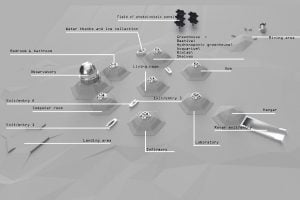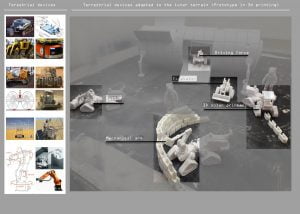Moon Camp Pioneers Gallery 2020-2021
In Moon Camp Pioneers each team’s mission is to 3D design a complete Moon Camp using Fusion 360. They also have to explain how they will use local resources, protect astronauts from the dangerous of space and describe the living and working facilities.
Team: Exagon moon base
Artistic high school “Dosso Dossi ” ferrara Italy 17, 18
External viewer for 3d project
|
Project description
The project develops phase 4, that is a permanent colony of 5 astronauts which is expected to be operational by 2040. The base consists of 10 modules containing the places necessary for survival on the Moon, those intended for research: laboratory, computer room , astronomical observatory and the hangar with the rovers and the repair shop; those intended for the astronaut’s daily life: nursing, gym, sleeping area and bathrooms, living area and kitchen, greenhouse, water recycling area. Outside the base there will be: the photovoltaic panels, the landing base, the emergency “Takeoff” base, the mining area to create the regolite blocks and extract production minerals. The modules have an architecture that recalls the historical ones of the planet earth, such as tholos and igloos. |
|||
|
Where do you want to build your Moon Camp?
It is hypothesized to place the settlements near the lunar south pole near the Tycho crater (43 ° 18 ′ 0 ″ S, 11 ° 13 ′ 12 ″ W (-43.3 °, -11.22 °). Tycho’s choice stems from the primary need to have a reserve of water and, from the latest data from the Chandrayaan-1 probe, there are excellent possibilities that there are deposits of water in solid form, in the areas of perennial shade in the various craters around Tycho. How do you plan to build your Moon Camp? Describe the techniques and materials you would use.
Prevalence of materials on site printing of elements in regolite. The main material used is regolite, plus the light modular elements transported from the earth. The base is made up of 10 self-sufficient multilayer hexagonal modules in order to allow for possible expansion. The whole structure has a quadruple layer: The first is a geodesic dome bio-layer, made up of sealed modules containing a fungus, Cladosporium sphaerospemum, with radiographic properties to limit the passage of solar radiation, a second airtight one in modular sealed aluminium panels which also provides thermal insulation, the third structural in regolith bricks and the last layer in regolith powder . The modules are connected between hexagonal corridors made from independent and isolated standard components. The environment on the Moon is very dangerous for the astronauts. Explain how your Moon Camp will protect them.
The triple layer, with very high thicknesses, will protect the base from the rain of micro meteorites, solar radiation and will allow it to have adequate living comfort. The external layer of regolite dust in addition to cushioning the micro meteors through the wall mass of this layer allows to mitigate the strong external thermal excursions 127 ° C -247 ° C approximately. Explain how your Moon Camp will provide the astronauts with:
|
|||
|
Water
|
Food
|
Electricity
|
Air
|
|
The water needs will be satisfied First of all with the supply from the earth, secondly through the recovery of the impact ice (comets or asteroids) through pre-arranged rovers, which will collect and transport them to a storage area where through the day-night excursion will pass from the solid to the liquid state will then be analyzed and then inserted into the closed cycle of the waters of the base. |
The daily needs of the astronauts will be prepared through a monitoring system of individual nutritional needs. A predominantly vegetarian diet is provided based on the foods produced by the greenhouse supplemented by fish and molluscs and crustaceans from aquariums and honey from bees. From the earth, if necessary, the diet can be supplemented with freeze-dried food and vitamins. |
Electricity is provided by photovoltaic panels located north of the greenhouse module at a distance of 10 meters for an area of about 400 square meters. composed of 5 modules in turn divided into 7 hexagonal cells. astronauts consume an average of 75-60 W. Energy can therefore be obtained with solar panels equipped with batteries that can conserve energy for the 2 weeks of darkness, through Tesla brand thermal generators. |
The plants grown inside the greenhouse and in all the other rooms of the base will be used for oxygen and in addition the electroplate will be used to obtain oxygen and water, and in addition to be more safe filters will also be inserted to prevent astronauts from suffocating in the CO2 they produce. To depressurize the environment, airlocks are present in the base entrances and corridors before entering the various rooms. |
|
Explain what would be the main purpose of your Moon Camp (for example: commercial, scientific, and/or tourist purposes).
The main purpose is scientific research to analyse more and more of the lunar soil and all its components, including minerals, in-depth research on the surrounding planets, physical, chemical and psychological study of how plants and animals grow on the base and in the future the second purpose of this permanent living colony is to become a tourist destination. |
|||
|
Describe a day on the Moon for your Moon Camp astronaut crew.
After waking up and having breakfast, they will go to the gym to optimize the first hour of daily training, which is essential for staying in shape. After training they will go to take a shower; then they will go to the various modules for the first two hours of work according to a calendar: some will go to the greenhouse to check the progress and parameters of the crops and collect the products to be consumed during the meals of the day, others will go to the computer room to pick up some radio communications with the Earth or to check the water, energy and air systems, others will take samples to be analyzed later in the second part of the day; meanwhile, the 4-step rovers will scout around the base to make sure there is no damage from solar radiation or meteor fragments. After concluding the first few hours of the program, the astronauts will have time to have lunch and relax in the living room, where they can watch TV, admire the aquarium and chat with each other. In the afternoon they will take care of the second shift: they will study and analyze the samples previously taken, continuing the astronomical research they will go to the observatory where they can study the surrounding planets; Checks will also be carried out outside the base, especially in the power station, the minerals will be extracted in the work area to be studied in the laboratory and the regolith will be extracted in the same area to build the bricks with which the base can be expanded. In the late afternoon they will carry out the last hour of training and then, after having refreshed themselves, have dinner. Late in the evening they will be able to communicate with relatives on Earth, watch a movie and take a walk outside or go to the observatory and, through a window, they will be able to enjoy the panorama of shooting stars while consuming popcorn cooked with the heat of the high temperatures reached from the Sun during the day. To conclude, three astronauts will go to sleep while the other two will remain awake to check the base during the night. |
|||







